Market Trend
Wednesday, July 26, 2006
Spotting market trends is probably one of the most difficult things to do for a marketer. However, predicting one ahead of time can probably make or break a company. (And if you are the marketer, you can probably make a lot of money and ride your success forever and ever.)
As of late, I've seen an increasing amount of female motorcycle riders. And it is not just one type of bike. I've seen Vespas, Harleys, race-styled bikes. What is curious about this "trend" is that I don't even live in a large city, so there must be something that is making more females become road warriors. Or perhaps I am just noticing now that I wear
glasses and details from far away become more apparent.
I wonder what
Faith Popcorn would have to say about my trend spotting abilities, if this is indeed a trend.
I think with some real research I can figure out what the motorcycle market looks like at the moment and check if there is an increase in females buying more than usual.
Will I do the research? Unlikely. I don't have any products that cater to motorcycle riders, but if I did, I would start digging for the reasons of this "trend."
Mirror and light experiment
Wednesday, July 19, 2006
I started using eye glasses 3 years ago. I don't like wearing them, but I have to since I'm required by law to wear them while driving--this is the only time I use them.
My prescription is for nearsightedness, which is an eye defect that focuses images incorrectly in front of the retina (I call it premature focusing), thus making far away images to appear fuzzy.
A few hundred years ago, someone figured out that using a diverging lens would force the light coming into the eye to properly diverge before hitting the cornea thus focusing properly in the retina--the cornea is just a natural "lens" inside our eyes.
Because of my defective eyes, I started thinking about plane or flat mirrors and how images reflect "off" of them.
I devised a simple experiment that goes like this:
- With my glasses on, I focus on an object far away--say a tree located about 500 meters away.
No surprises here, I can see the tree clearly.
- I take my glasses off and, appropriately, I can still see the tree, however, it looks fuzzy because of my nearsightedness.
At this stage I did a little thought experiment to answer the question "what would I see if I turn 180° and place a mirror in front of me, say 40 cm, so that I can see the tree behind me?" (Remember, I can clearly see things that are close to me.)
I started thinking about optics and the reflection of light and I immediately concluded that I would see the same tree as perfectly as I would with my glasses on. I hypothesized that the reflection of the tree is "created" 40 cm in front of me, therefore no fuzziness. I imagined the light bouncing off the mirror to hit my eye and only traveling 40 cm--I had invented another cure for nearsightedness, I thought.
At this point, I grabbed a mirror to corroborate the results of my thought experiment.
Was I right or was I wrong?
Some of you may already know that my hypothesis is wrong. It sounds logical (to me at least), however, human logic is not the same as nature's logic. I couldn't figure out why I was wrong.
(An interesting side note: if you don't suffer from nearsightedness, you can't confirm my results and you will have to take my word for it.)
The question to answer now is why is this so, i.e., why is the reflected image in the mirror, which is 40 cm in front of me, fuzzy without my glasses but not fuzzy if I put them on?
While it is true that the mirror is in front of me at a distance of 40 cm, the actual image reflected is still 500 m in front of me.
To prove the fact that the image in the mirror is actually 500 m away in front of me, I had to remember how mirrors actually work.
I eventually had to open up my undergrad Physics book to start my quest to understand why the empirical results differed from my thought results.
I have to say that It was quite a discovery for me, as I had never noticed this phenomena since eye glasses were not part of my every day life until 3 years ago.
I'll spare you all the theory of optics and quote directly from my book what is actually happening to the reflected image. Images formed by flat mirrors have the following properties:
- The image is as far behind the mirror as the object is in front.
- The image is unmagnified, virtual, and erect. (By erect we mean that, if the object arrow points upward, so does the image arrow.)
- The image has right-left reversal.
Note that these are not laws, but properties.How do these properties help me in answering my question?
Note property number 1: what it is saying is that any reflected image in front of a mirror generates a virtual image "behind" the mirror, and the distance of this virtual image is exactly the same distance as the real image in front of the mirror.
I think a diagram is helpful here--note that this diagram assumes the correct "particle" theory of light propagation so that "rays" of light propagate in straight lines (more on this below):
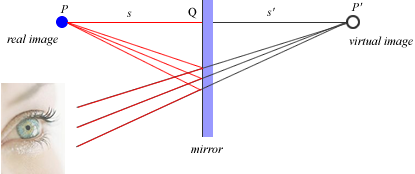
Obviously, there are more than three "rays" of light bounced off from the mirror as generated by the real image, however, simplicity is key to understand what is going on. What you should note, though, is that the distance
s is the same as
s', or the distance relative to the mirror for the real image is the same as the virtual image (which is the reflection of the real image).
There is one rule we can borrow from Geometry to support the statement "the real image's distance relative to the mirror is the same as the virtual image's distance relative the mirror": we can confidently say that because the triangle PQR is
congruent to the triangle P'QR, then
s = s' and
h = h'. See the image below to see what I mean by congruent:
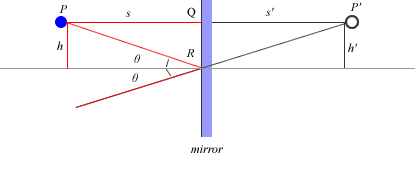
So if you believe in all that Geometry sorcery, you will agree with me that such statement makes sense, and you will also agree that the virtual image is actually located at s' distance behind the mirror, thus making total sense why without my glasses the image appears fuzzy.
If you are still reading carefully, you will object to this explanation and still ask why is this so?
Alright, let me continue.
I will ask us to imagine "rays" of light being bounced off the virtual image and that these rays do travel in a straight line.
Using Geometry again, I can confidently say that the angle of reflection of the real image coincides with that of the virtual image. Therefore the angle between the ray and its reflection is the same, namely θ or "theta."
Hence, by tracing lines around the diagram we can calculate what this angle should be, because we know where in the mirror the virtual image resides and we also know the real image's location. (Because of this geometry we can do other interesting things with reflected images--out of scope right now, but worth mentioning.)
So, Physicists will explain that the bounced "rays" of light are spreading as they should, therefore hitting your eye as if the image was located "behind" the mirror--in other words, what you are actually looking at is the virtual image after all, and not the "flat" reflection in the mirror, i.e., light is not actually "drawing" the reflection on the mirror, although it looks like it is because of the flatness of the mirror.
Now, I think, it should be clear why my thought experiment's result was wrong: the tree was not really 40 cm in front of me, but 500 m in front me "behind" the mirror. Silly me.
Am I happy with my own explanation? Actually, no.
After all the research and silly geometry tricks, I am not satisfied as to why this happens the way it happens. I think it is logically explained, however, why is property number 1 above true?
The problem with trying to understand the true nature of things leads to
really trying to understand, which is in itself frustrating because nature is not that simple. It is similar to the easy questions to ask that have no real satisfactory answer, for example, "why are we here?"
Anyway, looking further into why property number 1 above holds true has led me into more obscure and weird explanations of nature: Quantum Theory.
This brings in a bit of problem for me because Quantum Theory is not that simple to understand, and I probably need some extra mathematical training, beyond my Mathematics degree, to do real calculations that will satisfy my curiosity.
However, I found Richard Feynman's book
QED. The Strange Theory of Light and Matter very useful. Though, after reading it, I still don't have a satisfactory answer to my original question.
So nature is weird, but it is simple if you believe what theoretical physicists think is true about QED: according to Feynman, everything around us can be explained with the following three actions between photons and electrons (Chapter 3, page 85):
- A photon goes from place to place.
- An electron goes from place to place.
- An electron emits or absorbs a proton.
It is quite remarkable and seemingly possible that these three "simple" actions explain everything (except for gravitation) about our world, from chemistry to computers and even images reflecting off of mirrors.
So there is hope for me to understand why I was wrong and how my deficiency led me to waste my time wondering and creating thought experiments.
Can anyone clearly explain and fully convince me of why far-away reflected images from a mirror are still fuzzy to non-eye-glasses-wearer nearsighted people? I would really, really like to know...
(Diagrams are based on Chapter 35 and 36 of
Physics for Scientist and Engineers with Modern Physics, Third Edition, by Raymond A. Serway.)
The internet is not a truck; it's a series of tubes
Friday, July 14, 2006
I knew my wonky computer science
professors were lying to me: the
OSI Reference model is just not consistent with tubes.
How long is it taking you to receive "your internets"?
Behold, chairman of the Senate Commerce Committee, Senator
Ted Stevens of Alaska, USA:
From the recording:
I just the other day got, an internet was sent by my staff at 10 o'clock in the morning on Friday and I just got it yesterday. Why?
Because it got tangled up with all these things going on the internet commercially.
So you want to talk about the consumer? Let's talk about you and me. We use this internet to communicate and we aren't using it for commercial purposes.
We aren't earning anything by going on that internet. Now I'm not saying you have to or you want to discrimnate against those people [¿]
The regulatory approach is wrong. Your approach is regulatory in the sense that it says "No one can charge anyone for massively invading this world of the internet". No, I'm not finished. I want people to understand my position, I'm not going to take a lot of time. [¿]
They want to deliver vast amounts of information over the internet. And again, the internet is not something you just dump something on. It's not a truck.
It's a series of tubes.
And if you don't understand those tubes can be filled and if they are filled, when you put your message in, it gets in line and its going to be delayed by anyone that puts into that tube enormous amounts of material, enormous amounts of material.
Now we have a separate Department of Defense internet now, did you know that?
Do you know why?
Because they have to have theirs delivered immediately. They can't afford getting delayed by other people.
The Pac Man Pattern
Tuesday, July 11, 2006
Practice makes perfect, we've all heard at some time or another. And sometimes, with all the practice we start memorizing repeatable actions as part of our repertoire of whatever activity we are trying to master.
In Software Engineering, we've invented "patterns" to aid in system building--we claim that these patterns, to which we give cool sounding names such as "Proxy Pattern," are reusable solutions to hard problems. (Of course, in some cases, we tend to over-engineer our solutions with too many design patterns.)
In general, there are patterns everywhere (not only in softeng), and gaming is not the exception.
I am not an avid video game player because I get easily bored by the repetitive motions, however, I really like the classics such as Pac Man, Defender, and Tetris.
I spent many quarters on those money guzzling Pac Man machines, and I never realized that there are some tricks to the trade, or patterns. (Shame on me. Maybe, I didn't play enough--I blame my parents for not providing me with an infinite ammount of quarters.)
So for you experts want to be, you can start memorizing the "Cherry Pattern":
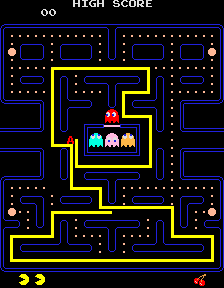
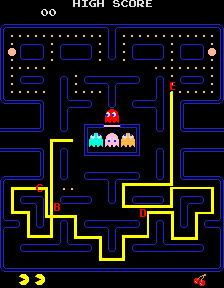
(It is a very complete
guide, on all accounts.)
What's the highest level you've reached in Pac Man?
Roberto Carlos failure to mark Henry sent Brazil home (maybe)
Thursday, July 06, 2006
It is hard to imagine what Brazil's players are going through. All the expectations of a whole nation (and perhaps a whole continent) placed on the legs of the best 11 players in the world.
Everyone expected them to win it all, and, because of the great expectations, their failure to even play beautifully in a world setting is even more hurtful--the media makes it sounds as if they betrayed their country.
And it almost feels like betrayal. I am not Brazilian, but I was in shock after their lost. I didn't want to speak to anyone and kept thinking how could it be that a team with the best players of professional football could perform so badly against an inferior opponent?
What happened to Brazil in the World Cup is the same thing that happened to Real Madrid in La Liga (Spain's first division league): many stars, very little results.
In this situation, who is to blame? There are many theories, for example:
- It was Ronaldinho's fault for not playing the way he always does.
- It was Ronaldo's fault for being too fat and not giving his place to Robinho.
- It was Cafu's fault for being too old and not giving his place to Cicinho.
- And the most likely one: it was Parreira's fault for not substituting tumbling Ronaldo for Robinho, for not substituting Cafu for Cicinho, for not putting one man to personally mark Zidane at all times, for not playing more quality teams while in training, for changing the starting line up without trying it first (subbing Juninho for Adriano?), etc., etc. I am certain you have read them all.
With all these theories, the one that has the most substance and the one that can be backed with proof is that Roberto Carlos forgot he was playing and just stood to watch Henry walk by him to score.
The evidence:
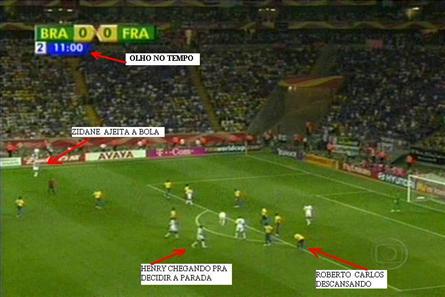
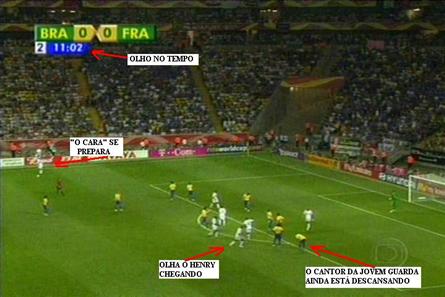
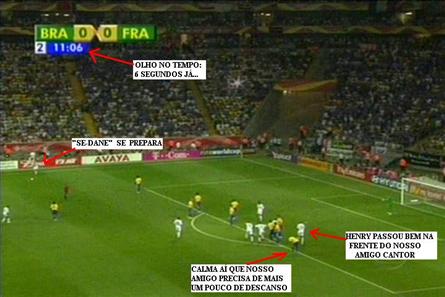
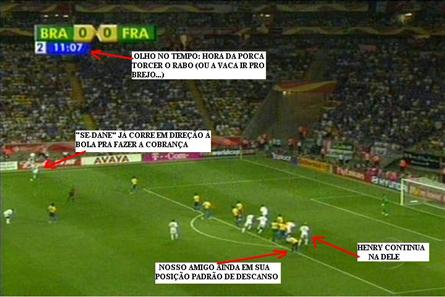
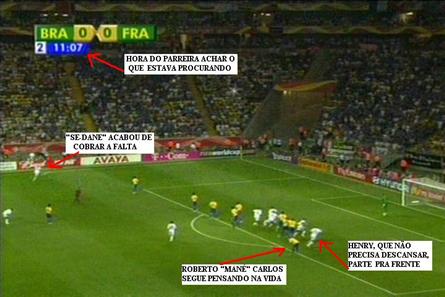
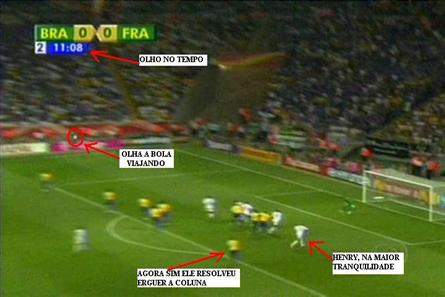
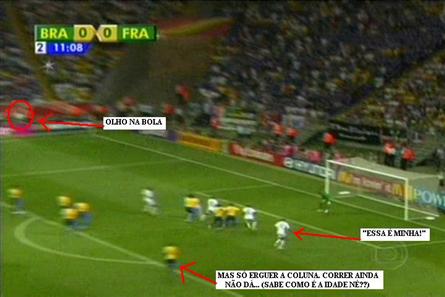
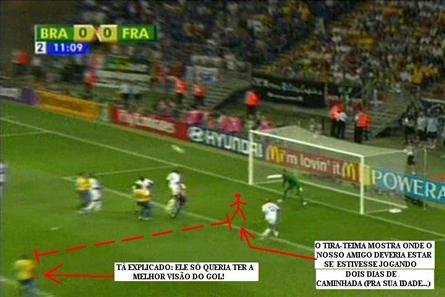
It is hard to argue that he failed to mark Henry. What was he doing? Why didn't he move?
It all comes down to a lack of focus and lost of concentration. In any other situation, his lack of movement while the free kick was being taken could have just been shrugged off and move on. However, giving that much space to a player of the quality of Henry means disaster in a nock-off situation.
To Brazil, it is the equivalent of treason: he may as well have sold national secrets to the enemy (whoever the enemy happened to be that day). Even revealing Ronaldo's weight to the world didn't have the consequences his 10 seconds of rest had.
Having looked at the evidence above, I don't believe Roberto Carlos is to blame for Brazil's elimination (better teams have come back from a one goal difference: Germany vs. Argentina). On the other hand, there is no question that his lack of marking led to Henry's goal.
Brazil played poorly throughout the tournament, and there were many technical errors around the bench. In my uneducated point of view, the best team won, however, Brazil had the best players of all time.
We'll see how a younger team performs in 2010. And goodbye to Ronaldo, Cafu, and Roberto Carlos--when you were at the top, you were the best.
(I wonder if there will Congressional hearings about Roberto Carlos's 10 second break at the 66th minute mark? It wouldn't surprise me. In 1998, Ronaldo actually had to answer questions in a Congressional hearing to explain why the team lost the FIFA 1998 World Cup.)
Intelligent life on Earth
Tuesday, July 04, 2006
Do you remember the "face" on Mars, and how it was linked to life on the planet?
Well, I think there is proof that there is "intelligent" life on Earth, too.
Check it out:
